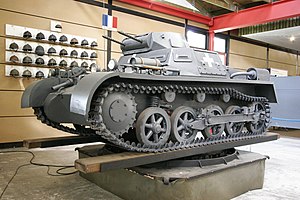 Global Information
Global InformationPanzer I information
| Panzerkampfwagen I Sd.Kfz. 101 | |
|---|---|
 A Wehrmacht Panzerkampfwagen I Ausf. A light tank on display at the Deutsches Panzermuseum Munster in Munster, Germany. | |
| Type | Light tank |
| Place of origin | Germany |
| Service history | |
| In service | 1934–1945 |
| Used by | Nazi Germany Bulgaria Republic of China Hungary Francoist Spain |
| Wars | Spanish Civil War World War II Second Sino-Japanese War |
| Production history | |
| Designed | 1932–1934 |
| Manufacturer | Henschel, MAN, Krupp, Daimler |
| Unit cost | 38,000 ℛ︁ℳ︁ (Ausf. B Without weapons) |
| Produced | 1934–1938, 1943 |
| No. built | 1,659 as light tanks 184 as command tanks |
| Specifications | |
| Mass | 5.4 tonnes (6.0 short tons) |
| Length | 4.02 m (13 ft 2 in) |
| Width | 2.06 m (6 ft 9 in) |
| Height | 1.72 m (5 ft 8 in) |
| Crew | 2: commander and driver |
| Armor | 7–13 mm |
Main armament | 2 × 7.92 mm MG 13 machine guns |
| Engine | Krupp M 305 four-cylinder air-cooled gasoline engine 60 PS (59 hp, 44 kW) |
| Power/weight | 11.1 PS (8.1 kW)/t |
| Suspension | Quarter-elliptical leaf spring suspension. |
Operational range | 200 km (120 mi) on-road; 175 km (109 mi) off-road. |
| Maximum speed | 37 km/h (23 mph) on-road; 25 km/h (16 mph) off-road. |
The Panzer I was a light tank produced by Nazi Germany in the 1930s. Its name is short for Panzerkampfwagen I (German for "armored fighting vehicle mark I"), abbreviated as PzKpfw I. The tank's official German ordnance inventory designation was Sd.Kfz. 101 ("special purpose vehicle 101").[2]
Design of the Panzer I began in 1932 and mass production began in 1934. Intended only as a training tank to introduce the concept of armored warfare to the German Army, the Panzer I saw combat in Spain during the Spanish Civil War, in Poland, France, the Soviet Union and North Africa during the Second World War, and in China during the Second Sino-Japanese War. Experiences with the Panzer I during the Spanish Civil War helped shape the German Panzerwaffe's invasion of Poland in 1939 and France in 1940. By 1941, the Panzer I chassis design was used as the basis of tank destroyers and assault guns. There were attempts to upgrade the Panzer I throughout its service history, including by foreign nations, to extend the design's lifespan. It continued to serve in the Spanish Armed Forces until 1954.
The Panzer I's performance in armored combat was limited by its thin armor and light armament of two machine guns, which were never intended for use against armored targets, rather being ideal for infantry suppression, in line with inter-war doctrine. As a design intended for training, the Panzer I was less capable than some other contemporary light tank designs, such as the Soviet T-26, although it was still relatively advanced compared to older designs, such as the Renault FT, still in service in several nations, and others. Although lacking in armored combat as a tank, it formed a large part of Germany's mechanized forces and was used in all major campaigns between September 1939 and December 1941, where it still performed much useful service against entrenched infantry and other "soft" targets, which were unable to respond even against thin armor, and who were highly vulnerable to machine gun fire. The small, vulnerable light tank, along with its somewhat more powerful successor the Panzer II, would soon be surpassed as a front-line armored combat vehicle by more powerful German tanks, such as the Panzer III, and later the Panzer IV, Panzer V, and Panzer VI; nevertheless, the Panzer I's contribution to the early victories of Nazi Germany during World War II was significant Later in the war, the turrets of many obsolete Panzer Is and Panzer IIs were repurposed as gun turrets on defensive fighting positions,[3] particularly on the Atlantic Wall.
- ^ Thomas L.Jentz, Hilary Louis Doyle: Panzer Tracts No.23 – Panzer Production from 1933 to 1945
- ^ Nomenclature see: Gander, Tanks and Armour: Panzerkampfwagen I & II, p. 10
- ^ Stannius, Mark. "Tank turrets". The Atlantic Wall in Denmark. Mark Stannius. Retrieved 28 December 2014.